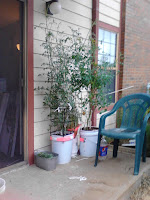The Book of Mormon mentions tower 26 times. The two in 2 Nephi are part of Isaiah's teachings, so don't say anything to the use of towers in the Book of Mormon. The one in Omni refers to the Jaredites who came to the Americas after the Tower of Babel incident. Two usages are in Mosiah, talking about King Benjamin's tower. That leaves 21 usages.
The next couple of references in Mosiah are to towers that the people of Limhi built in the Land of Nephi. The first one was built near the temple, "yea, a very high tower, even so high that he could stand upon the top thereof and overlook the land of Shilom, and also the land of Shemlon, which was possessed by the Lamanites; and he could even look over all the land round about." This observation tower may have been equipped with a telescope. Many don't think of the Nephites as being very inventive, but that's faulty thinking. There is sufficient evidence in the Book of Mormon to demonstrate their genius at inventions. The tower near the temple is refenced twice again in Mosiah.
King Noah built another tower, "a great tower . . . on the hill north of the land Shilom, which had been a resort for the children of Nephi at the time they fled out of the land."
Alma talks about every land of the people of Nephi having a tower in the days of Moroni, about 73 B.C.. 36 And it came to pass also, that he caused the atitle of liberty to be hoisted upon every tower which was in all the land, which was possessed by the Nephites; and thus Moroni planted the standard of liberty among the Nephites.
Also in the days of Moroni, he built towers in every fenced city as part of their protection. 4 And he caused towers to be erected that overlooked those works of pickets, and he caused places of security to be built upon those atowers, that the stones and the arrows of the Lamanites could not hurt them.
In the days of the kingmen, they were compelled to put the standard of liberty upon their towers: 20 And the remainder of those dissenters, rather than be smitten down to the earth by the sword, yielded to the standard of liberty, and were compelled to hoist the atitle of liberty upon their towers, and in their cities, and to take up arms in defence of their country.
But they also had many towers in the land of the Lamanites during these wars, as Alma tells us in chapter 48: 1 And now it came to pass that, as soon as aAmalickiah had obtained the kingdom he began to binspire the hearts of the Lamanites against the people of Nephi; yea, he did appoint men to speak unto the Lamanites from their ctowers, against the Nephites.
Amalickiah did this in order to rally an army to go against the Nephites. Amalackiah was successful in the use of towers to raise a substantial army, so great a number that he thought their sheer number alone would gain the advantage over the Nephites.
Mormon tells Moroni about the tower of Sherizzah, which the people evidently used to flee the Lamanties in Moroni 9: 7 And now I write somewhat concerning the sufferings of this people. For according to the knowledge which I have received from Amoron, behold, the Lamanites have many prisoners, which they took from the tower of Sherrizah; and there were men, women, and children.
It looks as though these were multi-purpose towers used for communication amongst the broader national community as well as safety for the individual communities. We don't have anything in the Book of Mormon that relates how far each tower could communicate, but we assume from King Benjamin's situation of having to send out the text of his sermon to those beyond his tower that at least at his time there were people outside the communication limits of his tower. Like in our day, where television and radio towers only have a certain radius of communication. However, did they have national stations that could broadcast to several local stations, as we do, or did they broadcast from station to station as a chain event? Those who think the Nephites enjoyed a relatively small possession of land, will necessarily believe they were limited in their scope. Those of us who believe the Nephites occupied a much larger, contential-size area, have another reason to understand why the Nephites, and the Lamanites, could communicate so well with each other while spread across a vast territory.




























